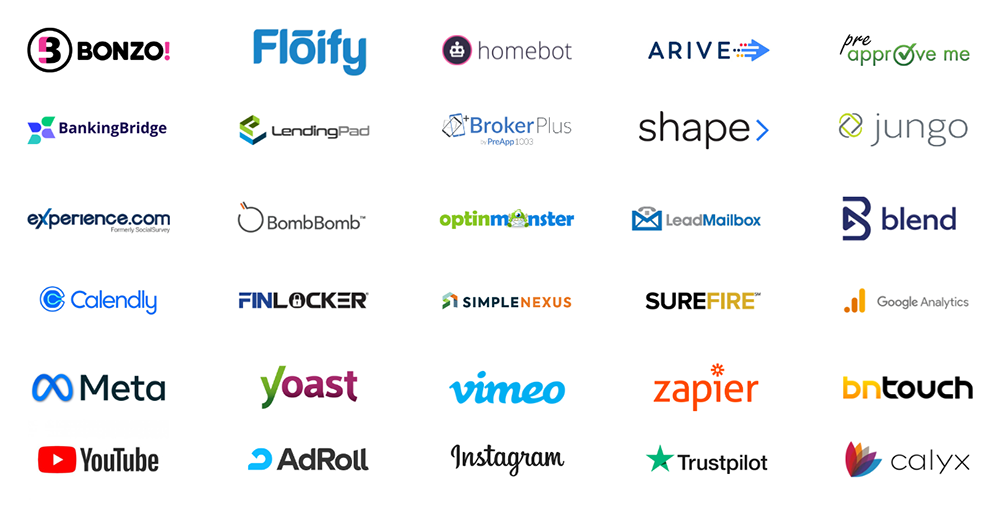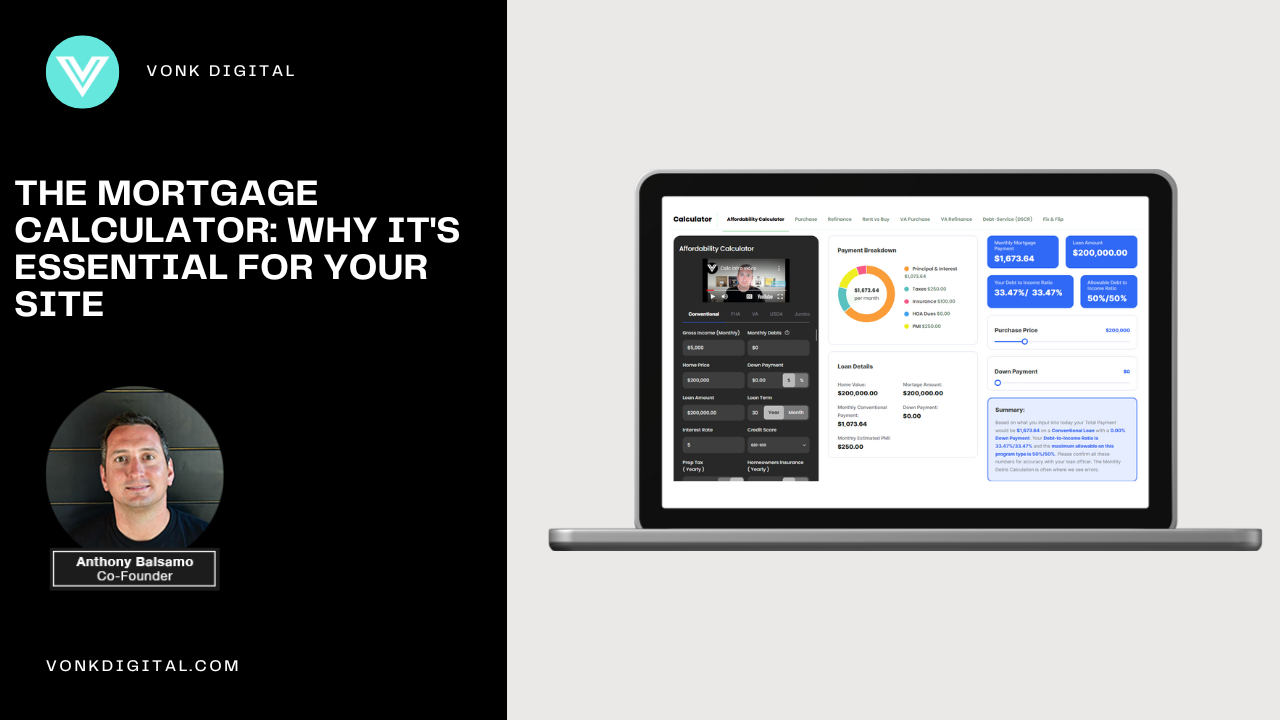People want to be able to do their own research on everything these days. The…

Integrating key features into mortgage websites is crucial for lenders to meet customer expectations and drive success. By seamlessly incorporating tools like loan calculators, lead forms, CRM, and online application forms, lenders and mortgage brokers can enhance the user experience, increase customer satisfaction, and boost conversions.
Understanding the Mortgage Website
Mortgage websites have become an essential tool for mortgage lenders, brokers, and loan officers in today’s digital age. These websites are a great way to show their services, attract clients, and make the mortgage process easier. To be competitive and give customers the best experience, strong integrations on these websites are crucial. Integrations help mortgage professionals easily connect tools and systems, offering a wide range of services that support the entire mortgage process.
Benefits of Integrations in a Mortgage Website
In today’s fast-paced mortgage industry, having a strong online presence is essential for success. Integrating a mortgage website has many benefits that improve the customer experience and increase efficiency. And possibly most importantly; a mortgage website will help you build trust with newer referral partners and your prospects when they look you up online.
One major advantage of integration is the ability to automate loan applications. By seamlessly connecting your website with backend systems, borrowers can complete and submit applications directly online. This streamlined process not only saves time but also improves accuracy, as data is automatically entered into the system.
Real-time lead generation and tracking are crucial for mortgage lenders. By integrating lead capture forms and CRM systems, you can capture prospective customer information and track their interactions with your website. This enables you to prioritize leads, personalize marketing campaigns, and improve conversion rates. We also recommend adding a Google Analytics tracking to your website to track page views, bounce rate, and where your website traffic is coming from.
Lastly, integration allows for personalized customer experiences. By leveraging data from various systems, you can tailor website content and offerings to match individual borrower preferences, increasing customer satisfaction and loyalty.
Overall, integrating a mortgage website has become essential in today’s competitive market. It makes customers happier, helps businesses run better, and leads to success for mortgage companies.
Essential Integrations for Mortgage Websites
In an increasingly digital world, having a strong online presence is crucial for mortgage industry professionals. A well-designed and functional website can be a powerful tool for attracting potential clients, showcasing services, and building credibility. To stand out in a highly competitive market, mortgage businesses need to integrate essential website features that maximize user experience, streamline the mortgage process, and facilitate effective communication with clients.
From incorporating loan applications and mortgage calculators to utilizing customer relationship management (CRM) software, integrating third-party integrations, and optimizing for mobile devices, there are several key features that should be considered to ensure a successful online presence in the mortgage industry. By leveraging these features, mortgage professionals can enhance customer experience, increase lead generation, and ultimately drive business growth.
Leads forms and your CRM
Leads forms and CRM software are essential features for mortgage websites, allowing mortgage brokers to effectively manage and track potential customers.
Leads forms are designed to capture important customer information such as name, contact details, and loan preferences. These forms can be customized and integrated with CRM software, ensuring that all leads are automatically captured and stored in one centralized system.
Once the leads are captured, the CRM software takes over, providing mortgage brokers with a range of functions to organize, track, and nurture leads. With a CRM, brokers can easily access and update contact information, keep detailed notes on customer interactions, and schedule follow-ups or reminders. This helps brokers provide personalized and prompt service, ultimately improving conversion rates and customer retention.
Furthermore, CRM software offers advanced features like customer segmentation, analytics, and automated marketing campaigns. Brokers can segment leads based on various criteria, create targeted marketing campaigns, and track their effectiveness. By leveraging these features, mortgage brokers can effectively engage potential customers, enhance the customer experience, and maximize their online presence.
Leads forms and CRM software are invaluable tools for mortgage brokers and mortgage websites. They allow brokers to capture potential customer information, seamlessly integrate with CRM software, and effectively manage leads. By harnessing these features, brokers can streamline their processes, engage with customers more effectively, and ultimately drive success in the mortgage industry.
Booking calendar such as Calendly
Integrating a booking calendar, such as Calendly, into a mortgage website is of utmost importance for loan officers and mortgage professionals. This feature allows potential clients to schedule appointments directly from the website, streamlining the communication process and enhancing the overall customer experience.
By implementing a booking calendar, potential clients can easily view the availability of loan officers or mortgage professionals and select a time slot that suits their schedule. This eliminates the need for back-and-forth emails or phone calls to find a suitable appointment time. Instead, clients can simply visit the website, choose a convenient time, and book the appointment instantly.
The benefits of using a booking calendar are manifold. Firstly, it provides a seamless experience for potential clients, as they can schedule appointments at their own convenience without the need for manual coordination. This convenience can significantly increase conversion rates, as it removes barriers to engagement.
Additionally, integrating a booking calendar helps loan officers and mortgage professionals optimize their time and resources. They can easily manage their schedules, allocate appropriate time for meetings, and maintain a more organized workflow. This ultimately leads to improved efficiency and productivity within the mortgage business.
In essence, by integrating a booking calendar such as Calendly into a mortgage website, potential clients can schedule appointments directly with loan officers or mortgage professionals. This feature enhances the customer experience, streamlines communication, and optimizes the workflow of mortgage professionals, resulting in a more efficient and effective lending process.
Online Loan Application
Integrating an online loan application feature into a mortgage website is crucial in today’s digital age. It allows potential clients to conveniently apply for a loan from the comfort of their own homes, streamlining the entire application process.
Online loan application software simplifies the loan application process for clients by providing a user-friendly interface. Clients can easily fill out the application form, upload necessary documents, and submit their application with just a few clicks. This eliminates the need for paper-based applications and reduces the time and effort required to complete the process.
Not only does the online loan application benefit clients, but it also facilitates the verification process for financial organizations. With all the required information and documents submitted electronically, lenders can readily access and review the information. This speeds up the verification process and allows lenders to make more informed decisions regarding loan approvals.
Having an easy-to-navigate loan application form is essential. It should include sections such as personal information, employment details, income and assets, and loan preferences. Each section should be clearly labeled and accompanied by tooltips or explanations to guide applicants through the process. Furthermore, the form should be responsive and optimized for mobile devices to accommodate users who prefer to apply on-the-go.
Integrating an online loan application feature into a mortgage website simplifies the application process for clients and enhances the efficiency of the verification process for financial organizations. An easy-to-navigate loan application form ensures a seamless user experience and improves the overall customer journey.
Google Analytics
One essential feature to integrate into a mortgage website is Google Analytics. By integrating this powerful tool, mortgage professionals can track and analyze their website traffic and user behavior.
To integrate Google Analytics into your mortgage website, start by signing up for a free Google Analytics account. Once you have your account, obtain the tracking code provided by Google. This code needs to be implemented on every page of your website.
With Google Analytics, you can gain valuable insights into your website’s performance. It provides data on the number of visitors to your site, where they are coming from, and which pages they are visiting most frequently. This information can help you better understand your audience and make informed decisions to improve your website’s user experience and conversion rates.
It’s important to note that while Google Analytics helps with website indexing, it does not guarantee higher search engine rankings. However, by using this service to analyze your website traffic and user behavior, you can optimize your mortgage website to meet the needs of your potential clients. By understanding how users navigate and engage with your site, you can make data-driven improvements to enhance their experience and drive more customer conversions.
Social Media Tracking Pixels
Integrating social media tracking pixels on your mortgage website is essential to track and analyze user engagement and conversion rates. These tracking pixels are snippets of code that you place on your website to collect valuable data from visitors who interact with your social media ads.
Tracking pixels work by capturing information about user behavior, such as the actions they take on your site, the pages they visit, and the products or services they are interested in. This data can then be used to retarget potential customers with personalized ads on social media platforms, increasing the likelihood of conversion.
Additionally, tracking pixels allow you to measure the effectiveness of your marketing campaigns. By analyzing the data collected, you can gain insights into which campaigns are driving the most engagement and conversions. This information can help you optimize your future marketing efforts and allocate your resources effectively.
Integrating social media tracking pixels on your mortgage website can provide valuable insights into user engagement and conversion rates. This allows you to effectively retarget potential customers and measure the success of your marketing campaigns. By leveraging this data, you can optimize your advertising strategy and achieve better results for your mortgage business.
Additional Integrations For Your Mortgage Website
Mortgage professionals need a strong online presence. To do this, mortgage websites must connect with software systems and tools. These connections improve business practices and customer experiences. They also make workflows more efficient. Mortgage professionals can stay ahead in lending by using technology and valuing connections. Let’s discover the power of integrating software systems for mortgage websites.
API Integrations
API integrations play a crucial role in the success of mortgage websites. A strong integration strategy allows mortgage professionals to seamlessly connect their websites with other software systems, such as mortgage CRMs and loan origination systems (LOS).
The key to effective API integrations is finding a mortgage CRM that offers robust APIs. APIs are like connectors for software systems. They let data exchange automatically between systems. With the availability of robust APIs, mortgage professionals can easily integrate their preferred CRM with existing software systems, avoiding the need for manual data entry and reducing the risk of errors.
One innovative development in API integrations is the use of GraphQL API surface layer. Mortgage websites can get data from multiple sources quickly and easily using GraphQL. This helps them work better and integrate more efficiently. This ensures that mortgage professionals have access to real-time, accurate information and can provide a seamless customer experience.
Using API integrations can make mortgage processes more efficient and improve customer satisfaction. Mortgage websites can connect with their CRM and LOS system through a strong integration strategy. This allows them to exchange data automatically, improving the lending process.
Common Questions
What platforms do mortgage brokers use?
Mortgage brokers use various platforms including CRM (Customer Relationship Management) software, loan origination systems (LOS), and mortgage calculators to manage client relationships, streamline the loan application process, and provide accurate loan estimates.
What is mortgage CRM software?
Mortgage CRM software is a specialized Customer Relationship Management platform designed for mortgage professionals. It helps manage client interactions, leads, document collection, and compliance, while also providing marketing automation tools to nurture relationships and referrals.
Do mortgage brokers use CRM?
Yes, mortgage brokers often use CRM software to organize client information, track interactions, manage loan applications, and automate marketing efforts to nurture leads and maintain relationships with past clients.


